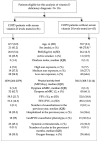Testing for Vitamin D in High-Risk COPD in Outpatient Clinics in Spain: A Cross-Sectional Analysis of the VITADEPOC Study
- PMID: 35268438
- PMCID: PMC8910945
- DOI: 10.3390/jcm11051347
Testing for Vitamin D in High-Risk COPD in Outpatient Clinics in Spain: A Cross-Sectional Analysis of the VITADEPOC Study
Abstract
Background: Vitamin D deficiency has been associated with an accelerated deterioration in lung function and increased exacerbations in chronic obstructive pulmonary disease (COPD). 25(OH) vitamin D levels have been indicated as a potentially useful marker for adverse results related to COPD. Methods: VITADEPOC is a cross-sectional clinical study recruiting consecutive patients with high-risk COPD. The objective of our study was to investigate vitamin D determination frequency in patients with high-risk COPD in clinical practice at outpatient clinics in Spain and to describe the factors associated with vitamin D testing. We also aimed to determine the frequency of vitamin D deficiency in these patients. Results: Only 51 (44%) patients underwent vitamin D determination and 33 (28.4%) had received vitamin D supplements in clinical practice. The patients who underwent testing for vitamin D in clinical practice were more often women (58.8% vs. 26.2%, p < 0.001) with comorbidities such as osteoporosis (19.6% vs. 6.2%, p < 0.001) or chronic renal failure (7.8% vs. 0%, p < 0.001) and with exacerbator phenotype (55% vs. 32.3%, p = 0.015). A total of 63 (54.3%) patients had serum vitamin D levels <20 ng/mL at the inclusion visit. Of these, 29 (46%) had serum vitamin D levels <12 ng/mL (severe deficiency). Having a history of inhaled corticosteroids (OR 3.210, p < 0.016), being treated with a cycle of systemic corticosteroids (OR 2.149, p < 0.002), and having a lower physical activity level (OR 3.840, p < 0.004) showed a statistically significant positive association with vitamin D deficiency. Conclusion: The testing of vitamin D levels in patients with high-risk COPD treated at outpatient respiratory clinics in Spain is infrequent. However, when tested, a severe deficiency is detected in one in four patients. Efforts to optimize case detection in COPD are needed.
Keywords: adherence to recommendation; chronic obstructive pulmonary disease (COPD); high risk; testing for vitamin D; vitamin D deficiency.
Conflict of interest statement
The authors declare no conflict of interest. The funders had no role in the design of the study; in the collection, analyses, or interpretation of data; in the writing of the manuscript; or in the decision to publish the results.
Figures




References
-
- Soriano J.B., Rojas-Rueda D., Alonso J., Antó J.M., Cardona P.J., Fernández E. Colaboradores de GBD en España; Lista de colaboradores de GBD en España. The burden of disease in Spain: Results from the Global Burden of Disease 2016. Med. Clin. 2018;151:171–190. doi: 10.1016/j.medcli.2018.05.011. - DOI - PubMed
Grants and funding
LinkOut - more resources
Full Text Sources

